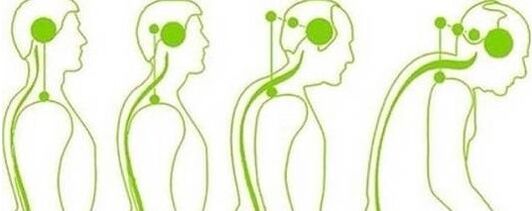Cervical osteocondrosis is developing more often in adults, but due to certain circumstances, a child can happen. When characteristic signs of this disease appear, it is necessary to contact a therapist or a profile profile specialist, a neurologist.

The degenerative destruction of the cervical disc of the spine of the spine characterizes the cervical osteochondosis. The gradual progression of the disease leads to damage to the intervertebral joints, the adjacent vertebrae and the binding apparatus. Many mistakenly believe that osteochondosis is the deposition of salts. However, this declaration is basically wrong. The salt can really be deposited in various joints, but with other pathologies, for example, due to the development of gout.
Thanks to the muscle system, the backbone of the human neck is held, consisting of seven vertebrae. In this area, the muscles are poorly developed, due to which, due to the long -term tension, fatigue occurs and spasms appear. In the future, the mobility of the cervical vertebrae becomes limited. As a result of this condition, the discs of the spine are gradually destroyed, which causes the beginning of the first stage of osteochondosis. In the absence of treatment, the disease progresses constantly, causing all the major injuries of the spine. In order to prevent the development of complications, it is necessary to pay attention to the first signs of pathology in time and take appropriate measures.
Very often, people like cervical osteochondrosis face people whose lifestyle includes a minimum of physical activity and sedentary work. In such a person, with the utmost probability, the first characteristics can already occur at the age of 25-30. Among the children from the child to adolescence, the disease is less common, but it can also occur due to a lifestyle or incorrect heredity, other irritating factors.
Phase of the development of the pathology and their intrinsic symptoms
The entire process of development of osteochondosis of the cervical column is divided into 4 main phases, each of which is accompanied by some symptoms. The treatment completely depends on the established gravity of the disease. For example, the first preclinical stage does not require pharmacological treatment. To improve the patient's condition, it is recommended to radically review the lifestyle: perform physical exercises and eat well. The characteristics of this phase: the excessive tension of the muscles of the whole back, the rapid appearance of a feeling of fatigue, a slight but tangible pain in the moments of the curves and the inclinations of the head. The main disadvantage in this case can be distinguished that few people attribute due importance to these symptoms, therefore they do not immediately turn to the hospital.

The following symptoms are characteristic of the second degree osteochondrosis:
- The pain when moving the head becomes more intense and periodically gives behind, to the hands, even to the lower back;
- Pain syndrome can occur in a calm state;
- There are headaches without cause;
- Attention is scattered, the level of work capacity is reduced.
All the above symptoms cannot continue to go unnoticed, therefore, for the most part, at this stage of the disease, the patient seeks medical assistance. The strengthening of pain is due to a decrease in the distance between the intervertebral discs and the violation of the nerves. An even greater aggravation of the situation occurs in the third phase. In this case, neck pain constantly disturbs, the muscles of the hands become very weak, from time to time it occurs numb. As for general symptoms, dizziness and weakness become the patient's daily companions. The cervical column loses mobility.
Unbearable pain in the neck, shoulders, arms, ears in the ears, a complete compromised coordination and the appearance of evident signs of other diseases indicate the beginning of the fourth final phase of the osteochondosis. At the same time, the intervertebral discs are destroyed and the pathological process moves further along the spine, affecting other departments. Such a degree of illness is difficult to treat, while surgery can be needed at the discretion of the doctor. Therefore, with the appearance of symptoms such as: pain in the neck and creak during the movements of the head, hands of the hands, dizziness, nausea, headache, hands, as well as fatigue and coordination problems should become an alarming signal that indicates real health problems. Do not delay a visit to the doctor, it is better to contact a therapist or immediately for a neuropathologist.
In the process of progression of the cervical osteocondrosis, a violation of the spinal spine may occur. Several sensitive and motor disorders may appear, depending on the spine, which has suffered:
- Partial or complete loss of sensitivity of the occipital region, anywhere of the neck, shoulders and arms;
- pain in any of the areas of the neck, shoulders, forearms, hands, up to the tips of the fingers;
- numbness of the language, which is why the speech is compromised;
- decrease in the muscle tone of the head and neck;
- Problems with respiratory function, pain in the heart and liver.

The protruding edges of the vertebrae can squeeze the arteries through which the blood enters the brain. Therefore, blood circulation in the brain is disturbed and further symptoms appear: a strong change of mood, insomnia, anxiety without cause, fear, irritability. At the same time, with spasm of blood vessels, not only headache, but pain in the eye can also happen. Patients often notice the appearance of "flies" in the eyes, sometimes fainting are possible.
The reasons for the development of cervical osteochondosis
The most common cause of the appearance of cervical osteochondrosis is considered a sedentary lifestyle in combination with an improper and unbalanced diet. Often not only lazy people suffer from their nature, but also those whose profession obliges most of the time to spend or in the same uncomfortable pose: office employees, vehicle drivers, etc. Such a lifestyle causes a constant load on the cervical vertebrae, which is the reason why muscle spasms arise. The appearance of degenerative processes in the discs is due to a violation of metabolic processes and blood circulation. Other reasons for the development of cervical osteoonscrosis include:
- Excess weight caused by unhealthy nutrition;
- Rheumatism, scoliosis, posture problems, plates;
- trauma of the spine and neck;
- Regular stress, nervous overexation;
- hereditary motif;
- Innate improper development of the cervical vertebrae.
Too zealous game sport, which means that excessively intense physical activity can also become the previous factor in cervical osteochondosis. Primary disease in such conditions is often a disc. The latter characterizes dystrophic disorders in the intervertebral discs, mainly lumbar and cervical discord. In this case, osteochondrosis is a consequence of a disc. In addition to the exclusion of a strong physical effort, with this diagnosis, a complex treatment, drug and physiotherapy is needed.

The consequences of progressive pathology
Among the complications that can occur with the development of the osteochondosis of the cervical region should be distinguished:
- The hernias and the protrusion in the spine are formed in the third, fourth phase due to the rapid progression of the underlying disease;
- The growth of bone tissues or the formation of osteophytes - are often arrue of protrusions. Osteophytes have an irritating effect on the muscles located nearby, increasing the tone. Therefore, the pressure on the intervertebral discs increases. In addition, educated osteophytes can cause narrowing of the arteries;
- The flattening of the spinal disc: a decrease in the intervertebral hole leads to a decrease in the height between the intervertebral discs, increases the risk of a subluxation of the cervical vertebrae with a clear rotation of the head;
- Spondilolistz or the movement of the spinal disk often do not often occur like other complications above, however, in the event of a occurrence, death can even cause death. Any minimum change in the position of the intervertebral disc with the utmost probability leads to paralysis, to a more significant shift - until death.
Cervical osteochondrosis always causes an increase in blood pressure. In addition, the transition of the disease below from one phase to another contributes to the progression of hypertension from the first to the third degree, to which the pressure exceeds the sign of 180 mm. Hypertension treatment directly helps to reduce the severity of symptoms, but only temporarily. In the case of unworthiness osteochondosis, it is impossible to get rid of the increase in blood pressure. In the case of damage to the disc between the cervical vertebrae 4 and 5, as a complication, periartritis occurs. It characterizes the pinch of nerves located in the connection of the shoulder joint with the hand. At the same time, severe pain in the shoulder occurs, with a negative effect on the mobility of the entire limb. Furthermore, osteochondrosis manifestations cannot be based on the signs of a heart disease, for example Angina Pectoris, but thanks to the diagnostic measures, it is possible to differentiate diseases with high precision.
It is impossible to determine the osteochondosis of the cervical column by palpation and as a result of a visual medical examination. On the basis of the history collected, the doctor can only assume that the osteochondosis precisely has become the cause of some symptoms. To confirm or refute this hypothesis, diagnosis is required. The most optimal way today is a magnetic resonance imaging or magnetic resonance therapy. This method allows you to consider all bone structures, identify the presence of intervertebral hernias, the dimensions of osteophytes and other characteristic complications of cervical osteochondosis. Another slightly less informative way is computerized tomography. It allows you to establish a diagnosis, however, the determination of the dimensions of the Harnia, since its presence could be difficult.

Treatment of cervical osteochondosis
The treatment of osteocondrosis of the cervical region is always complex and complex. Its duration and saturation depend on the stage of the development of the disease, the individual characteristics of the patient and the presence of other concomitant diseases. Among the main groups of drugs, which are often prescribed in the second and further phases, one should distinguish:
- Analgesics or painkillers. The funds listed help to temporarily reduce pain. With too pronounced pain, the local block of Novocaine is used.
- Anti -non -steroidal anti -inflammatory drugs and anti -steroid -inflammatory drugs. Non -short agents are safer, have an analgesic effect and can become an alternative to ordinary analgesics. In the event that the pain does not relieve, steroid drugs are used.
- Antidepressants and sedatives - Motherwort, Valerian's tincture. Their purpose is due to two factors: if the cause of the osteocondrosis is a nervous overstraine or if the pain is so serious that it has a negative effect on the psyche. The use of these drugs should be carried out under close observation, since each of the drugs has a series of contraindications and is dependence.
- Musorelassants who help to relieve muscle spasms. In combination with anti -inflammatory drugs, they have an analgesic effect.
- Vasransdilatori who contribute to the improvement of blood circulation.
- Drugs to increase immunity and normalization of metabolic processes are ideal for vitamins B and C.
The complex of these drugs is a symptomatic treatment. Respect for all the doctor's recommendations and the passage of the prescribed course will help to eliminate the pain and get rid of all the unpleasant manifestations of the disease. However, the therapeutic course does not end there. When the main characteristics are eliminated, which has worsened the quality of life, it is possible to take restore of the cervical region in order to minimize the risk of recurrence of the disease in the near future. Unfortunately, a huge mistake of many people is that after the disappearance of the symptoms, they consider themselves completely healthy and abandon the treatment. In this situation, osteochondrosis will certainly remember itself after a while.
Physiotherapy and traditional medicine
The following physiotherapy procedures are successfully used to treat cervical osteochondrosis:

- Medical physical education - is carried out exclusively under the supervision of a qualified specialist, since with serious injuries of the intervertebral discs, incorrect exercises can hurt the tissues even more;
- Manual therapy - is a manual effect on some areas of the patient's body;
- therapeutic massage;
- reflexology and, as variety, acupuncture;
- Electrophoresis, bathing, laser therapy, UFO, etc.
Each of the above procedures has a series of contraindications, which is particularly important for those who have an anamnesis of other diseases that are not related to the osteochondosis of the cervical column. The decision on the adequacy of the use of a particular method remains with the attending physician. It may not be sure to perform such measures of your free will. As for traditional medicine, you can use the grass of a Saber fish, Crusca. Fig. It is also recommended to reduce the intake of salt. A responsible approach to the treatment of cervical osteochondosis will certainly allow you to get rid of the disease. Let this process requires a lot of time, but only complex therapy will minimize the possibility of ri -Sviluppo of the disease.


























